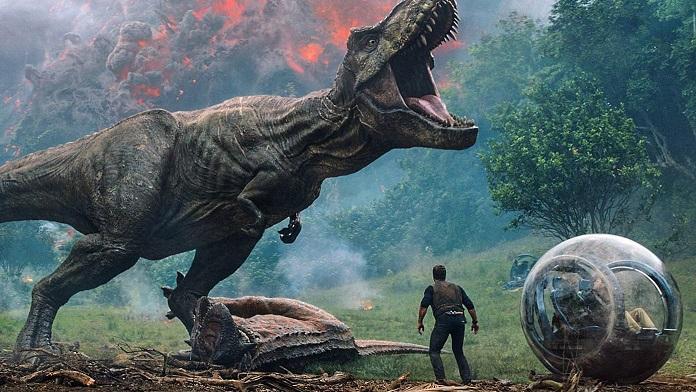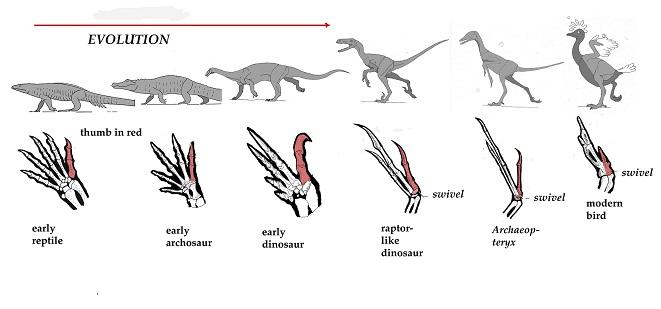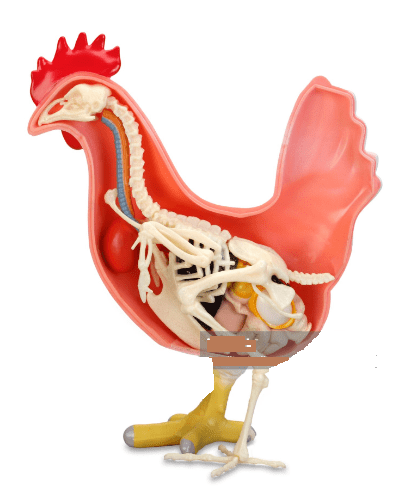Ever glanced at a chicken and thought, “Could you possibly be related to the mighty T-Rex?”
As an evolutionary biology enthusiast, I’ve delved deep into this peculiar topic.
The bridge between chickens and dinosaurs isn’t just a figment of pop culture; it’s rooted in scientific inquiry.
In this article, we’ll explore the connection, dispel myths, and equip you with fascinating insights.
So, are chickens dinosaurs? Let’s hatch the mystery.
Table of Contents
Are Chickens Really Dinosaurs? The Scientific Perspective
While casual observers may chuckle at the notion, serious scientific inquiries have addressed the question: ‘’Is a chicken a dinosaur?’’ These discussions revolve around paleontological discoveries, genetic comparisons, and evolutionary science.
Why the Question Arises
Movies, novels, and myths have woven tales of fierce, massive creatures. But beyond these, there’s scientific intrigue that fuels the question.

Pop Culture vs. Science
Hollywood has painted a vivid picture of dinosaurs, but when we cut through the fictional drama, we discover a nuanced and detailed scientific narrative. Are chickens dinosaurs in the way movies portray them? Probably not, but there’s more to the story than fiction offers.
The Uncanny Resemblance
Spotting a chicken pecking might not evoke thoughts of a T-Rex. Yet, upon closer examination, many of their features—like skeletal structures and certain behavioral patterns—align with prehistoric reptiles, stoking the fires of debate.
Birds as Living Dinosaurs
Birds flitting in the sky are, evolutionarily speaking, a testament to Earth’s prehistoric past. It prompts the exploration: ‘’do chickens come from dinosaurs?’’
How Some Dinosaurs Evolved Into Birds
Life’s evolutionary journey is vast and varied. Dinosaurs didn’t merely vanish into the annals of history; some transitioned, through a series of adaptive steps, into the diverse avian species we’re familiar with today.
Feathers, Beaks, and Other Adaptations
It’s a mesmerizing tale of transformation where scales morphed into feathers, fearsome jaws transitioned to beaks, and creatures of enormous stature downsized for aerial mastery. This gradual transformation underscores the chicken’s evolution from dinosaurs.
Tracing the Chicken’s Evolutionary Journey
In unraveling the mysteries of evolution, tracing the lineage of any species can be a revelation. For those wondering, ‘’Are chickens related to dinosaurs’’, the journey of the chicken from ancient times to the present might hold some surprising answers.

Step-by-Step Evolution
Evolution, often seen as a complex web of progressions and regressions, is better understood when broken down step by step. With chickens, it’s no different.
Anatomical Changes Over Time
The chicken’s anatomy reveals fascinating insights into its evolutionary path. Initially, bird-like dinosaurs or avian dinosaurs, like Archaeopteryx, showcased a mix of features: teeth, wings, and a long tail.
But as we traverse through time, the teeth vanished, the wings became more defined, and the long reptilian tail transformed into a pygostyle (the fused end of the backbone). These changes reflect the intricate dance of evolution, where nature experiments, adapts, and refines based on environmental demands.
Geographic Spread and Habitual Changes
Starting from dense forests where early birds sought refuge from predators, the avian lineage, including ancestors of modern chickens, began to diversify and inhabit varied terrains.
Over millions of years, as continents drifted and climates shifted, these early birds underwent significant habitual changes. From dense forested areas, they moved to open grasslands, with some species even conquering air travel.
Their dietary habits evolved too, transitioning from a diet rich in insects and smaller prey to incorporating grains and seeds. This geographic spread and adaptation is a testament to the tenacity of the lineage leading to our modern-day chickens and offers insight into the question: do chickens come from dinosaurs?
Genetic Evidence
Beyond fossils and anatomy, the very essence of life—DNA—provides pivotal clues in the evolutionary story.
DNA Comparisons
Recent advancements in genetic sequencing have permitted comparisons between chicken DNA and that of its ancient relatives. The findings have been astounding. Certain genetic markers, remnants from their dinosaur ancestors, still persist in chickens.
For instance, genes responsible for teeth formation, dormant in chickens, can be activated under specific conditions, leading to chicken embryos with rudimentary teeth, reminiscent of their prehistoric ancestors.
Such revelations not only reaffirm the chicken’s evolution from dinosaurs but also showcase the marvels of genetic memory, where fragments of an ancient past persist within the very fabric of life.
The Fossil Record: What Stones Tell Us
When it comes to answering the question, are chickens dinosaurs?, one cannot overlook the crucial evidence fossils provide. These ancient remnants bear witness to life’s intricate tapestry, chronicling evolutionary tales etched in stone.
Significant Fossils in the Dino-Bird Debate
The fossil record, particularly in the context of birds and dinosaurs, is awash with intriguing finds, each deepening our understanding of the evolutionary relationship. The discovery of the Archeopteryx, often regarded as the “first bird,” has been pivotal.
Hailing from the late Jurassic period, it displays a remarkable blend of avian and reptilian features. With feathered wings and toothed jaws, Archeopteryx provides a tantalizing glimpse into the transition from dinosaurs to birds.
Then there’s the Velociraptor, a name familiar to many. Although pop culture often depicts them as menacing, scale-covered creatures, evidence suggests otherwise. Fossils bearing quill knobs indicate the presence of feathers on these predators.
Such findings reinforce the notion that birds, including chickens, share a deep-rooted lineage with certain dinosaur species.
Interpreting Fossil Evidence
While unearthing fossils is an accomplishment, discerning their stories is where the real challenge lies. Fossils not only offer structural insights but also provide cues about prehistoric behaviors.
Indirect evidence, such as nest structures or footprints, suggests that many dinosaur species exhibited behaviors seen in modern birds. For instance, the communal nesting habits of certain dinosaurs echo those of contemporary chickens.
Additionally, the context in which a fossil is found, the layer of sediment, and its relative position in the geological timeline can offer insights. Radiometric dating techniques help pinpoint when a particular species existed, painting a clearer picture of the evolutionary steps leading to present-day birds.
Unique Traits: Chickens vs. Other Birds
For the casual observer, a chicken might appear as just another bird but dive deeper, and its unique attributes start to surface. This distinction often leads to the question: is a chicken a dinosaur? The traits and scientific research surrounding chickens may offer some clues.
Why Chickens Stand Out?
Among the vast avian family, chickens occupy a peculiar space. Their distinct characteristics and evolutionary lineage not only pique curiosity but also emphasize their importance in understanding bird evolution.
Specific Features Tying Back to Dinosaurs
Chickens display certain morphological features that echo their ancient ancestors. The arrangement of their pelvic bones, for instance, resembles that of some theropod dinosaurs.
Moreover, their three-toed feet, though common among many birds, closely mirror the foot structure of specific dinosaur species. The very act of a chicken brooding over its eggs, enveloping them with warmth, harkens back to similar behaviors observed in fossilized dinosaur nests.
These compelling ties accentuate that chicken evolution from dinosaurs is not a mere conjecture but grounded in observable traits.
Chickens in Scientific Research
Chickens have become a staple in evolutionary biology research. Scientists, while probing the question, do chickens come from dinosaurs, often turn to the chicken genome. The chicken DNA, surprisingly, still holds dormant sequences that, when activated, can manifest ancient traits.
In one groundbreaking study, researchers managed to modify chicken embryos to develop snouts resembling their dinosaur predecessors rather than beaks. Such experiments, while ethically debated, underscore the chicken’s invaluable role in decoding the mysteries of avian and dinosaur evolution.
Debunking Common Myths and Misconceptions
In our quest to understand the fascinating relationship between chickens and dinosaurs, it’s essential to separate fact from fiction. The question “Are chickens dinosaurs” often gets entangled in webs of popular myths, spurred on by media depictions and deep-rooted misconceptions.
Popular Culture and Media
Cinema, literature, and even cartoons shape our perceptions, sometimes leading us astray from scientific truths. Jurassic parks and monstrous, scaly beasts might be entertaining, but they don’t always present an accurate evolutionary picture.
While movies can rouse our imagination, they don’t always adhere to the latest paleontological findings. The portrayal of dinosaurs without feathers or the absence of any representation suggesting that chickens come from dinosaurs are glaring examples.
Furthermore, headlines often chase sensationalism. A statement like “Chickens are direct descendants of the T-Rex” might capture attention, but it oversimplifies the complex web of chicken evolution from dinosaurs.
Commonly Held But Incorrect Beliefs
Over the years, several myths have taken root, obscuring the intricate evolutionary narrative.
Chickens Are Not Related to Dinosaurs At All
Contrary to this belief, scientific evidence, from genetics to fossil records, affirms that chickens are related to dinosaurs. The answer is a resounding yes.
Dinosaurs Never Had Feathers
Recent fossil discoveries show imprints of feathers on many dinosaur species, debunking this myth and bridging the avian-dinosaur divide.
All Dinosaurs Were Massive
While we often visualize titanic creatures, many dinosaur species were small, some even chicken-sized!
If Chickens Were Dinosaurs, They Would Be Dangerous
Evolution tailors species to their environment. Modern chickens, while having a lineage tracing back to certain theropods, have evolved into domesticated creatures, far from the predators of the Mesozoic era.
Birds Evolved from Mammals, Not Dinosaurs
A common misconception, but genetic and anatomical evidence firmly plants birds in the dinosaur evolutionary branch.
Only Herbivorous Dinosaurs Evolved into Birds
Actually, it’s primarily the carnivorous theropods, like raptors, that are closely related to modern birds.
Chickens Are Too Dumb to Have Dinosaur Ancestry
Intelligence and evolutionary lineage are not correlated. While chickens might not ace an IQ test, their behaviors and instincts are perfectly adapted to their ecological niche.
Genetic Engineering Could Easily Turn a Chicken into a Dinosaur
While some studies have tinkered with chicken genes to induce ancient traits, the complete transformation is far from reach, and the ethical implications are vast.
All Dinosaurs Went Extinct
If we take the perspective that birds are modern-day dinosaurs, then it’s evident that not all dinosaurs vanished from our world.
Evolutionary Links Are Merely Theories, Not Supported by Evidence
The word ‘theory’ in science signifies a well-substantiated explanation. The evolutionary links between birds and dinosaurs are backed by a plethora of evidence, from DNA to fossils.
Comparison and Resemblance: Chickens vs. Dinosaurs
| Aspect | Chickens | Dinosaurs |
| Anatomy | Three-toed feet, pelvic bones resembling some theropods, brooding over eggs | Theropods had similar foot structure, pelvic bones, and potentially brooding behaviors |
| Feathers | Present | Found in certain dinosaur species, e.g., Velociraptor |
| Size | Small, domesticated | Varied from small to massive |
| Diet | Omnivorous, grains & seeds dominant | Varied, some carnivorous |
| DNA | Contains dormant dinosaur-related genes | Original sequences, some found in chicken DNA |
| Behavior | Communal nesting, specific brooding behaviors | Some exhibited similar nesting habits |
| Evolutionary Transition | Descended from theropod dinosaurs | Some species evolved into birds |
Conclusion
From the profound imprints of fossils to the DNA within today’s birds, our exploration reveals a fascinating lineage. The connection between chickens and their majestic dinosaur ancestors is undeniable.
As we close this chapter, we’re reminded that nature is full of wonders, and sometimes, the most extraordinary stories lie hidden beneath the feathers of the seemingly ordinary.
FAQs
Are chickens descended from dinosaurs?
Yes, chickens are descended from a group of theropod dinosaurs.
Was the T-Rex related to a chicken?
The T-Rex and chickens share common ancestors, making them distant relatives.
What did chickens evolve from?
Chickens evolved from theropod dinosaurs, specifically the Maniraptora group.
What is the closest animal to a dinosaur?
Birds, especially chickens, are the closest living relatives to dinosaurs.
How did the transition from dinosaurs to birds occur?
Dinosaurs transitioned to birds through gradual evolutionary adaptations like feather development.
What are some of the key evolutionary changes that led to the development of chickens?
Key changes include the growth of feathers, reduction in size, and beak development.
Alina Hartley is a small-town girl with a ginormous love of bearded dragons. It all started with Winchester, a baby bearded who was abandoned at the shelter by his former owners because of a birth defect that caused one front leg to be shorter than the other. Alina originally went to the shelter looking for a guinea pig, but one look at Winchester and it was love at first sight. From that day on, Alina has dedicated her life to learning everything she can about bearded dragons. She loves helping new beardie parents start their incredible journey with these magnificent reptiles.
Follow her on:
LINKEDIN
TWITTER.
Read her latest articles HERE
Learn more about her HERE.

